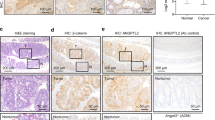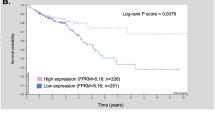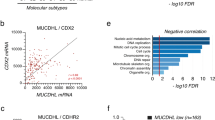Abstract
The carcinoembryonic antigen cell adhesion molecule 1 (CEACAM1) is downregulated in colonic and intestinal hyperplastic lesions as well as in other cancers, where it functions as a tumor suppressor. To investigate the functions of CEACAM1 in the normal intestine and in intestinal tumors, we generated a compound knockout mouse model and examined both Ceacam1−/− and Apc1638N/+:Ceacam1−/− mice. Ceacam1−/− intestinal cells exhibited a significant decrease in apoptosis, with no change in proliferation or migration, however. Compound Apc1638N/+:Ceacam1−/− mice demonstrated an increase in intestinal tumor multiplicity and tumor progression. Increases in intussusceptions and desmoid lesions were also observed. We have shown that CEACAM1-L associates with β-catenin by co-immunoprecipitation and colocalization in CEACAM1-L-transfected CT26 and CT51 mouse colon carcinoma cells. Ceacam1−/− enterocytes displayed decreased glycogen synthase kinase 3-β activity with corresponding nuclear localization of β-catenin. Increased T-cell factor/Lef transcriptional activity was observed in CEACAM1-null CT51 colonic cells and in Caco2 colon cancer cells in which CEACAM1 was downregulated. A significant increased expression in c-Myc and cyclin D1 targets of the Wnt signaling pathway was also revealed in the Ceacam1−/− intestine. CEACAM1 therefore actively participates in Wnt signaling in intestinal cells and its downregulation in intestinal tissue contributes to malignancy by augmenting tumor multiplicity and progression.
This is a preview of subscription content, access via your institution
Access options
Subscribe to this journal
Receive 50 print issues and online access
$259.00 per year
only $5.18 per issue
Buy this article
- Purchase on Springer Link
- Instant access to full article PDF
Prices may be subject to local taxes which are calculated during checkout





Similar content being viewed by others
References
Abou-Rjaily GA, Lee SJ, May D, Al-Share QY, Ruch RJ, Neumaier M et al. (2004). CEACAM1 modulates epidermal growth factor receptor-mediated cell proliferation. J Clin Invest 114: 944–952.
Aoki K, Aoki M, Sugai M, Harada N, Miyoshi H, Tsukamoto T et al. (2007). Chrosomomal instability of β-catenin/TCF transcription in APC or β-catenin mutant cells. Oncogene 26: 3511–3520.
Azar T, Berger DL . (1997). Adult intussusception. Ann Surg 226: 134–138.
Beauchemin N, Draber P, Dveksler G, Gold P, Gray-Owen S, Grunert F et al. (1999). Redefined nomenclature for members of the carcinoembryonic antigen family. Exp Cell Res 252: 243–249.
Buckhaults P, Rago C, St Croix B, Romans KE, Saha S, Zhang L et al. (2001). Secreted and cell surface genes expressed in benign and malignant colorectal tumors. Cancer Res 61: 6996–7001.
De la Chapelle A . (2004). Genetic predisposition to colorectal cancer. Nat Rev Cancer 4: 769–780.
Demant P . (2003). Cancer susceptibility in the mouse: genetics, biology and implications for human cancer. Nat Rev Genet 49: 721–734.
Dveksler GS, Pensiero MN, Dieffenbach CW, Cardellichio CB, Basile AA, Elia PE et al. (1993). Mouse hepatitis virus strain A59 and blocking antireceptor monoclonal antibody bind to the N-terminal domain of the cellular receptor. Proc Natl Acad Sci USA 90: 1716–1720.
Fodde R, Edelman W, Yang K, van Leewen C, Carlson C, Renault B et al. (1994). A targeted chain-termination mutation in the mouse Apc gene results in multiple intestinal tumors. Proc Natl Acad Sci USA 91: 8969–8973.
Fodde R, Smits R . (2001). Disease model: familial adenomatous polyposis. Trends Mol Med 7: 369–373.
Fodde R, Smits R, Clevers H . (2001). APC, signal transduction and genetic instability in colorectal cancer. Nat Rev Cancer 1: 55–67.
Gray-Owen SD, Blumberg RS . (2006). CEACAM1: contact-dependent control of immunity. Nat Rev Immunol 6: 433–446.
Hanahan D, Weinberg RA . (2000). The hallmarks of cancer. Cell 100: 57–70.
He TC, Sparks AB, Rago C, Hermeking H, Zamel L, Da Costa LT et al. (1998). Identification of c-MYC as a target of the APC pathway. Science 281: 1509–1512.
Hokari M, Matsuda Y, Wakai T, Shirai Y, Sato M, Tsuchiya A et al. (2007). Tumor suppressor carcinoembryonic antigen-related cell adhesion molecule 1 potentiates the anchorage-independent growth of human hepatoma HepG2 cells. Life Sci 81: 336–345.
Horst AK, Wagener C . (2004). CEA-related CAMs. Human Exp Pharmacology 165: 283–341.
Horst AK, Wulf DI, Dabelstein J, Schumacher U, Sander H, Turbide C et al. (2006). Carcinoembryonic antigen-related cell adhesion molecule 1 modulates vascular remodeling in vitro and in vivo. J Clin Invest 116: 1596–1605.
Hsieh J-T, Luo W, Song W, Wang Y, Kleinerman DI, Van NT et al. (1995). Tumor suppressive role of an androgen-regulated epithelial cell adhesion molecule (C-CAM) in prostate carcinoma cell revealed by sense and antisense approaches. Cancer Res 55: 190–197.
Jin L, Li Y, Chen CJ, Sherman MA, Le K, Shively JE . (2008). Direct interaction of tumor suppressor CEACAM1 with beta-catenin: interaction of key residues in the long cytoplasmic domain. Exp Biol Med 233: (in press).
Kinzler K, Vogelstein B . (1996). Lessons from hereditary colorectal cancers. Cell 87: 159–170.
Kobrossy L, Rastegar M, Featherstone M . (2006). Interplay between chromatin and trans-acting factors regulating the Hoxd4 promoter during neural differentiation. J Biol Chem 281: 25926–25936.
Korinek V, Barker N, Morin PJ, van Wichen D, De Weger R, Kinzler KW et al. (1997). Constitutive transcriptional activation by a β-catenin-Tcf complex in APC−/− colon carcinoma. Science 275: 1784–1787.
Kunath T, Ordonez-Garcia C, Turbide C, Beauchemin N . (1995). Inhibition of colonic tumor cell growth by biliary glycoprotein. Oncogene 11: 2375–2382.
Leung N, Turbide C, Marcus V, Jothy S, Beauchemin N . (2006). Carcinoembryonic antigen-related cell adhesion molecule 1 (CEACAM1) contributes to progression of colon tumors. Oncogene 25: 5527–5536.
Liu W, Wei W, Winer D, Bamberger AM, Bamberger C, Wagener C et al. (2007). CEACAM1 impedes thyroid cancer growth but promotes invasiveness: a putative mechanism for early metastases. Oncogene 26: 2747–2758.
Morin PJ, Sparks AB, Korinek V, Barker N, Clevers H, Vogelstein B et al. (1997). Activation of β-catenin-Tcf signaling in colon cancer by mutation in β-catenin or APC. Science 275: 1787–1790.
Nagaishi T, Pao L, Lin SH, Iijima H, Kaser A, Qiao SW et al. (2006). SHP1 phosphatase-dependent T cell inhibition by CEACAM1 adhesion molecule isoforms. Immunity 25: 769–781.
Najjar SM . (2002). Regulation of insulin action by CEACAM1. Trends Endocrinol Metab 13: 240–245.
Neumaier M, Paululat S, Chan A, Matthaes P, Wagener C . (1993). Biliary glycoprotein, a potential human cell adhesion molecule, is down-regulated in colorectal carcinomas. Proc Natl Acad Sci USA 90: 10744–10748.
Nittka S, Gunther J, Ebisch C, Erbersdobler A, Neumaier M . (2004). The human tumor suppressor CEACAM1 modulates apoptosis and is implicated in early colorectal tumorigenesis. Oncogene 23: 9306–9313.
Nollau P, Scheller H, Kona-Horstmann M, Rohde S, Hagenmuller F, Wagener C et al. (1997). Expression of CD66a (human C-CAM) and other members of the carcinoembryonic antigen gene family of adhesion molecules in human colorectal adenomas. Cancer Res 57: 2354–2357.
Notterman DA, Alon U, Sierk AJ, Levine AJ . (2001). Transcriptional gene expression profiles of colorectal adenoma, adenocarcinoma, and normal tissue examined by oligonucleotide arrays. Cancer Res 61: 3124–3130.
Obrink B . (1997). CEA adhesion molecules: multifunctional proteins with signal-regulatory properties. Curr Opin Cell Biol 9: 616–626.
Patel S, Doble B, Woodgett JR . (2004). Glycogen synthase kinase-3 in insulin and Wnt signalling: a double-edged sword ? Biochem Soc Trans 32: 803–808.
Poy MN, Ruch RJ, Fernstrom MA, Okabayashi Y, Najjar SM . (2002a). Shc and CEACAM1 interact to regulate the mitogenic action of insulin. J Biol Chem 277: 1076–1084.
Poy MN, Yang Y, Rezaei K, Fernstrom MA, Lee AD, Kido Y et al. (2002b). CEACAM1 regulates insulin clearance in liver. Nat Genet 30: 270–276.
Rowan AJ, Lamlum H, Ilyas M, Wheeler J, Straub J, Papadopoulou A et al. (2000). APC mutations in sporadic colorectal tumors: a mutational “hotspot” and interdependence of the “two hits”. Proc Natl Acad Sci USA 97: 3352–3357.
Sansom OJ, Meniel VS, Muncan V, Phesse TJ, Wilkins JA, Reed KR et al. (2007). Myc deletion rescues Apc deficiency in the small intestine. Nature 446: 676–680.
Smits R, van der Houven van Oordt W, van Oordt W, Luz A, Zurcher C, Jaqmohan-Chanqur S et al. (1998). Apc1638N: a mouse model for familial adenomatous polyposis-associated desmoid tumors and cutaneous cysts. Gastroenterology 114: 275–283.
Takayama T, Ohi M, Hayashi T, Miyanishi K, Nobuoka A, Nakajima T et al. (2001). Analysis of K-ras, APC, and beta-catenin in aberrant crypt foci in sporadic adenoma, cancer, and familial adenomatous polyposis. Gastroenterology 121: 599–611.
Turbide C, Kunath T, Daniels E, Beauchemin N . (1997). Optimal ratios of biliary glycoprotein isoforms required for inhibition of colonic tumor cell growth. Cancer Res 57: 2781–2788.
van de Wetering M, Sancho E, Verweij C, De Lau W, Oving I, Hurlstone A et al. (2002). The beta-catenin/TCF-4 complex imposes a crypt progenitor phenotype on colorectal cancer cells. Cell 111: 241–250.
Velcich A, Yang WC, Heyer J, Fragale A, Nicholas C, Viani S et al. (2002). Colorectal cancer in mice genetically deficient in the mucin Muc2. Science 295: 1726–1729.
Vivona AA, Shpitz B, Medline A, Bruce WR, Hay K, Ward MA et al. (1993). K-ras mutations in aberrant crypt foci, adenomas and adenocarcinomas during azoxymethane-induced colon carcinogenesis. Carcinogenesis 14: 1777–1781.
Yang WC, Bancroft L, Liang J, Zhuang M, Augenlicht LH . (2005). p27Kip1 in intestinal tumorigenesis and chemoprevention in the mouse. Cancer Res 65: 9363–9368.
Acknowledgements
We thank Dr Daniel Dufort for plasmid constructs, Dr Jason Young for antibodies and Dr Nathalie Rivard for helpful comments. This work was supported by grants from the National Cancer Institute of Canada, the Canadian Cancer Society and the Miriam and Saul Goldberg Innovative Research Award (NB) and a Canadian Institutes of Health Research Training Grant (NL).
Author information
Authors and Affiliations
Corresponding author
Additional information
Conflicts of interest
None of the authors have conflicts of interest.
Supplementary Information accompanies the paper on the Oncogene website (http://www.nature.com/onc).
Supplementary information
Rights and permissions
About this article
Cite this article
Leung, N., Turbide, C., Balachandra, B. et al. Intestinal tumor progression is promoted by decreased apoptosis and dysregulated Wnt signaling in Ceacam1−/− mice. Oncogene 27, 4943–4953 (2008). https://doi.org/10.1038/onc.2008.136
Received:
Revised:
Accepted:
Published:
Issue Date:
DOI: https://doi.org/10.1038/onc.2008.136
Keywords
This article is cited by
-
The role of CEA-related cell adhesion molecule-1 (CEACAM1) in vascular homeostasis
Histochemistry and Cell Biology (2016)
-
Host-related carcinoembryonic antigen cell adhesion molecule 1 promotes metastasis of colorectal cancer
Oncogene (2013)
-
Carcinoembryonic antigen-related cell adhesion molecules (CEACAMs) in cancer progression and metastasis
Cancer and Metastasis Reviews (2013)
-
Increased metabolic rate and insulin sensitivity in male mice lacking the carcino-embryonic antigen-related cell adhesion molecule 2
Diabetologia (2012)
-
MiniSOX9, a dominant-negative variant in colon cancer cells
Oncogene (2011)



